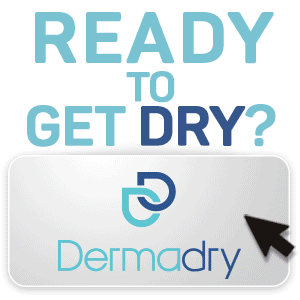The question I get asked the most is What is the cure for hyperhidrosis? There isn’t one, at least not yet. But, there are a variety of treatments for hyperhidrosis, both prescription and over-the-counter. In the following video, I discuss a few of the treatments for excessive sweating that I’ve tried.
Prefer to read this instead? Just scroll down to the transcript below. You can also read more about my trip to film this patient perspective video on hyperhidrosis.
What kind of treatment were you offered after you received the diagnosis for hyperhidrosis initially?
My initial treatment option after I was diagnosed with hyperhidrosis was a prescription-strength antiperspirant. This was around age 12 the first time they offered me a solution. And so they told me to apply it to my hands and feet at night and then wrap my hands and feet in Saran Wrap and go to bed. And that’s not very practical, so the patient compliance for me was very low, especially at age 12 when I’m a middle schooler and it’s not very cool to wrap your hands in Saran Wrap.
So that was my first foray into treatment options. And then once I started doing my own research and went to an actual dermatologist at age 21 and heard the term hyperhidrosis for the first time, they prescribed some oral medications. I tried metoprolol which is a beta blocker initially. That did not work for me and it made me very dizzy and very tired. And then we moved on to an anticholinergic called glycopyrrolate. That gave me a little bit of dry mouth for a while and really did not decrease my sweating overall. So I would say those treatments failed.
What kind of, if any, over-the-counter topical products have you tried?
Over-the-counter products that I’ve tried for hyperhidrosis have been clinical strength antiperspirants. I’ve tried a bunch of different brands of those, and there is another newer over-the-counter product called Carpe for hyperhidrosis.

Try Carpe lotion for hyperhidrosis! It helps me manage my sweaty hands, feet, underarms and other body parts.
Can you describe your pharmacy experience when you had to go pick up, or receive, or obtain medication?
When I went to pick up my prescriptions at the pharmacy, I don’t think the pharmacist realized that these medications were being prescribed for excessive sweating. The prescriptions were written obviously by a dermatologist who was more familiar with the condition, but not once did the term hyperhidrosis come up in that initial discussion with the pharmacist. They didn’t realize that it was being prescribed as an off-label use to treat excessive sweating.
How much have topical products helped you to treat your hyperhidrosis?
I think topical products for hyperhidrosis do have a place in treatment. They’re easy to access because they’re over the counter. They don’t require a prescription and I can walk into the store or go online and have immediate access to them. I found that some topical lotions for excessive sweating work, but they don’t work all of the time. But, even if it improves my quality of life for even just a matter of hours, then to me it’s worth that investment.
What kind of adverse events have you experienced with topical products you’ve used?
The adverse events I’ve experienced with topical products that are over the counter include a rash on my underarms after applying a clinical strength antiperspirant. It didn’t matter if I had just shaved or if I waited a few days and then applied the product. The extreme itching was so bad that it would wake me up at night, and I would have to apply hydrocortisone cream just to be able to go back to sleep. So the itching combined with the rash made me not want to use those products because it’s not worth the pain and the irritation in that case to stop my sweating.
Lastly on the prescriptions, what additional prescription drugs or devices have you used?
The other prescription devices or drugs that I’ve tried include an iontophoresis machine. I’m still working with that machine to see if it helps my quality of life. It takes a bit of courage to use an iontophoresis machine because you’re placing your hands and/or your feet into a tray of electrical water which sounds counterintuitive. And so it can be panic inducing and it can be scary. And the other thing with iontophoresis is that it takes a lot of time to treat yourself. It’s 20 minutes of treatment and then you switch the polarity and then it’s another 20 minutes. So you have to dedicate at least 45 minutes to this procedure either daily or several times per week. So patient compliance can be low if you’re short on time. You really have to be able to devote the time and the energy to this treatment. So I’m still trying to decide whether that works for me because it is scary to put your hands into electricity with water.
Video footage is courtesy of Pharmacy Times Continuing Education (PTCE) and is from their continuing medical education (CME) activity titled “Examining Hyperhidrosis (Excessive Sweating): A Managed Markets Update on New Treatments, Featuring a Patient Perspective” and was featured as a supplement in the December 2018 edition of the American Journal of Managed Care (AJMC).
This post contains affiliate links, and the purchases you make help me pay for the costs associated with owning this website. Thank you for your sweaty support!



